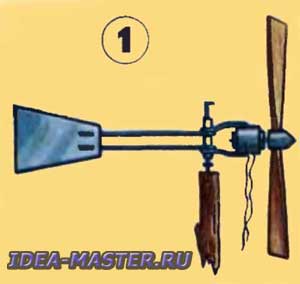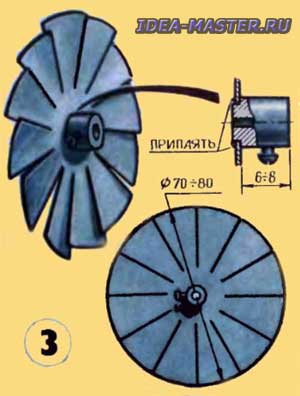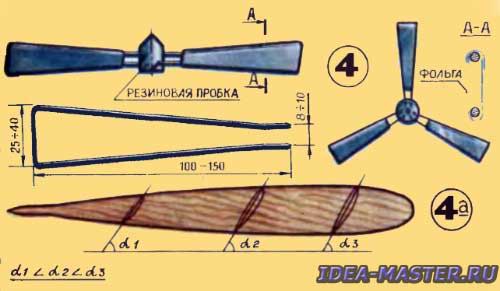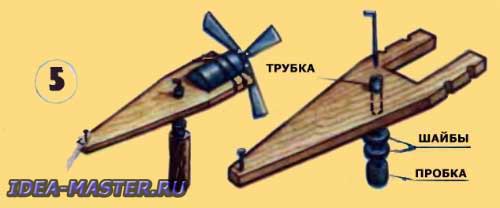A homemade camping power plant. How to make a mini generator with your own hands
A pocket flashlight has become an item of equipment for every tourist. Yes, that's the trouble — you have to save battery energy. But you can take a power plant with you. It weighs almost as much as a spare 4.5 V battery, and it won't take much more space in the backpack. Let's tell you: the electric generator of our self-made camping power plant is almost any microelectromotor of direct current with excitation from permanent magnets, and the energy source is wind.
Hiking power station
 The principle of operation of a self-made camping power plant — a mini-generator is shown in Figure 1. A current generator with a propeller is mounted on a pole. Wires go from the generator to the light bulb. The propeller automatically «follows» the wind with the help of a weather vane — «tail». The challenge is how to make the power plant as simple and easy as possible. It is also necessary that it can be easily disassembled into parts, and the main components could be repaired or made anew from improvised means right in the campaign.
The principle of operation of a self-made camping power plant — a mini-generator is shown in Figure 1. A current generator with a propeller is mounted on a pole. Wires go from the generator to the light bulb. The propeller automatically «follows» the wind with the help of a weather vane — «tail». The challenge is how to make the power plant as simple and easy as possible. It is also necessary that it can be easily disassembled into parts, and the main components could be repaired or made anew from improvised means right in the campaign.
Let's start with the generator. The easiest way to get microelectromotors of the Moscow plant «Young Technician» type DP-1 or TIR-1. When buying them in the store, try to choose those whose rotor rotates more easily. The smallest the power plant will work if you use microelectric motors of the KM USH-a-38 type, which are manufactured in Germany and sold here as spare parts for railway models. And if you have the opportunity to use PD-3 type microelectromotors (of any series), the power plant will turn out to be the most powerful. However, these engines are the heaviest of all named. The main dimensions of all listed engines are shown in Figure 2.

A propeller is needed to rotate the generator. There are many variants of its design. However, for field conditions, a propeller is preferred, which can be easily removed from the generator shaft, or with folding blades. The removable propeller is shown in Figure 3.
 It is made from the bottom of a tin can. A boss, turned on a lathe, is soldered into the center. A hole is drilled in the boss and a thread is cut for the MZ screw. The angle of inclination of the blades is about 30°. The number of blades is from 8 to 12.
It is made from the bottom of a tin can. A boss, turned on a lathe, is soldered into the center. A hole is drilled in the boss and a thread is cut for the MZ screw. The angle of inclination of the blades is about 30°. The number of blades is from 8 to 12.
The simplest design with folding blades is shown in Figure 4. The blades are made of wire, for example spring wire, of the OVC brand, with a diameter of 1-1.5 mm and wrapped with foil. The pointed ends of the wire are stuck into holes previously pierced in a rubber stopper-boss. The angle of inclination of the blade is the same as in the first design. The central hole in the boss is best drilled with a drill or on a lathe. A tube of a suitable diameter with a length of 20-25 mm should be soldered to the shaft of the electric motor. Drill a hole in the boss with a drill with a diameter of 0.5-1 mm, smaller than the outer diameter of the tube. Such blades need to be made with a margin of five pieces, which will allow you to change the characteristics of the propeller depending on the strength of the wind. If you forget the blades at home, do not despair. They can be cut from a suitable piece of wood (Fig. 4a) or even use the feathers of large birds instead.

The wind, as a rule, is capricious and often changes direction. Therefore, complete the set of parts with another one — a weather vane. Its constructions are shown in Figures 1 and 5.

In the plate (Fig. 5) with a length of 200-300 mm, make a groove according to the size of the electric motor. The engine is attached to it with wire, twine or rubber bands from pharmacy bottles. Drill a hole as close as possible to the engine in the center of the plate. Here, on a pin made of wire with a pointed end, the weather vane will be mounted on a pole. To improve its rotation, insert a 30-50 mm long tube into the hole. At the end of the plank, drive a nail. Attach a «tail» to it: a handkerchief, a long ribbon or a washcloth, like a kite.
The power plant is ready. If necessary, the power plant can be made to work on the go. However, in this case it is better to use a 1.5 V light bulb. It will burn bright enough even in windless weather if you walk at a brisk pace.
There is a pocket power plant business at home. By replacing the bulb with a 1-1.5 A DC ammeter or a 3-5 V voltmeter, you will get a device for measuring wind speed. However, for this you will have to calibrate the scale of readings.
All materials of the section «Ideas for the master»
| Share this page on social networks: |
